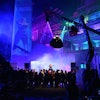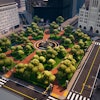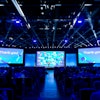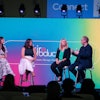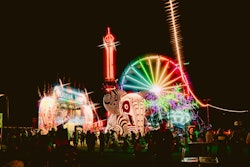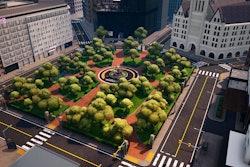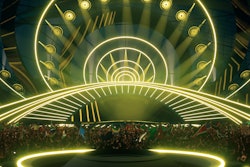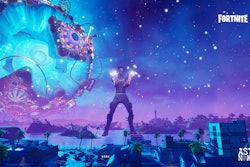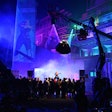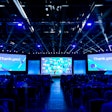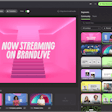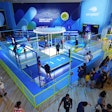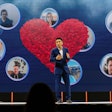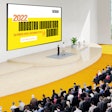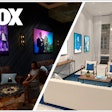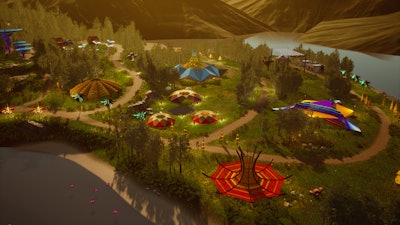
Like many music festivals, this year's in-person Lightning In a Bottle (LIB), the music and arts fest slated to be held at Buena Vista Lake in Southern California, was canceled due to the coronavirus pandemic.
And like many event organizers, LIB’s producers, the production company The Do LaB, decided to go digital. The virtual version, DGTL LIB, took place May 22-24; it was livestreamed via Twitch and included a corresponding Zoom party, all of which drew 1.5 million viewers.
During the Memorial Day weekend event, attendees gathered in a virtual landscape that mimicked the IRL festival grounds, complete with its iconic stages and structures, including multiple versions of the Woogie Stage, the Lighting Stage, the Beacon, the Grand Artique, yoga tents, and even flamingo pool floats.
 Silhouetted figures within the virtual landscape danced during performances.Photo: Courtesy of Vita Motus Design Studio
Silhouetted figures within the virtual landscape danced during performances.Photo: Courtesy of Vita Motus Design Studio
The design firm intimately understood the aesthetics of the event, having collaborated with The Do LaB and the festival for 14 years. “In this time, we have witnessed the ongoing search for the perfect festival location,” Shaw said, “and in all of the moves, we can remember what was the highlight of each one. In constructing the virtual landscape, we were able to combine the best of all these worlds into one. This is a perfect example of the freedom that digital environments afford their designers.”
During the three-day festival, select artists such as Kaytranada, CloZee, and Opiuo performed within the virtual grounds. Plus, during performances from Shiba San and Tokimonsta, a new lake stage design was revealed.
Vita Motus, who boasts clients like Cirque Du Soleil, Shakira, Mariah Carey, and A$AP Rocky, was able to design the entire environment in only two weeks, all while adhering to social distancing guidelines. “Designing the digital festival grounds and stages were comparatively relatively straightforward, as we already had the 3-D models of them from when they were originally built out,” Shaw said. “The level of production we’re striving for requires the integration of set design, lighting design, programming, VJing, video-mapped content, and camera capture of the live broadcast. And while this is nothing new for us, physical distancing requires the teams and artists to collaborate from their respective remote locations across the globe.”
Shaw also added that although DGTL LIB was the team’s first foray into the digital festival experience, working virtually isn’t new. “In our typical design process, we spend quite some time in the virtual space using a variety of pre-visualization tools before we get to physically build out the show. We feel like this is just the cusp, as we continue to utilize our live show experience to evolve technology-driven entertainment.”
As for the artist sets, Vita Motus provided the performers with remote technical direction on how to set up a green screen, so the design firm could capture their performances and integrate them into the virtual scene.
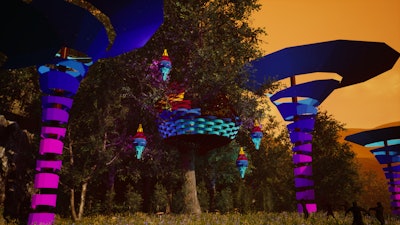 “We choose to see this as an inspiring time to be in the virtual space because we find more freedom in creation with less concern around things like gravity, scale, and engineering; we can design and build otherwise impossible structures and worlds," Shaw said.Photo: Courtesy of Vita Motus Design Studio
“We choose to see this as an inspiring time to be in the virtual space because we find more freedom in creation with less concern around things like gravity, scale, and engineering; we can design and build otherwise impossible structures and worlds," Shaw said.Photo: Courtesy of Vita Motus Design Studio
“While digital experiences will never replace live events, the opportunities to enhance and augment them with integrated technology is the future of fan participation,” Shaw said. “We choose to see this as an inspiring time to be in the virtual space because we find more freedom in creation with less concern around things like gravity, scale, and engineering; we can design and build otherwise impossible structures and worlds. This has also started to re-inspire our work in the physical space, as we rediscover how to design with less limitations. We believe there are endless possibilities, and we hope the work we’ve done for DGTL LIB has helped to lay the foundation for more festivals to see this as a viable option.”
The Vita Motus team also predicts there will be more integration of avatars and user-generated content in these virtual spaces, as well as the development of tools to easily allow attendees and artists to contribute to the event.
“We are inspired by the community’s overwhelmingly positive response to DGTL LIB; it means the show isn’t over, it’s just changed format a bit for the time being,” Shaw said. “Technological innovations can help us to bridge the physical gaps between us, making it possible for artists to entertain and maintain the connection to their audience. We think this solidifies our trajectory to virtualize live production during this time—to create an entertaining, fully livestreamed space where artists, brands, and events can continue to engage their audiences, pay their workers, share their art, support their talent, and produce beautiful and inspiring activations.”
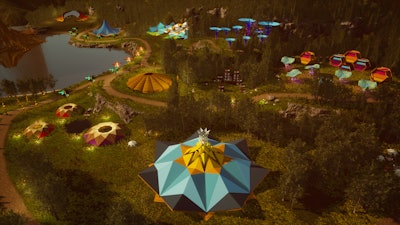 In addition to the performances, the festival also included workshops, yoga, and other activations.Photo: Courtesy of Vita Motus Design Studio
In addition to the performances, the festival also included workshops, yoga, and other activations.Photo: Courtesy of Vita Motus Design Studio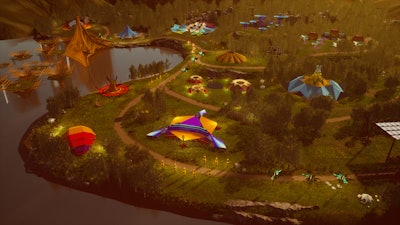 DGTL LIB attendees gathered in a virtual landscape that mimicked the IRL festival grounds, complete with its iconic stages and structures.Photo: Courtesy of Vita Motus Design Studio
DGTL LIB attendees gathered in a virtual landscape that mimicked the IRL festival grounds, complete with its iconic stages and structures.Photo: Courtesy of Vita Motus Design Studio
